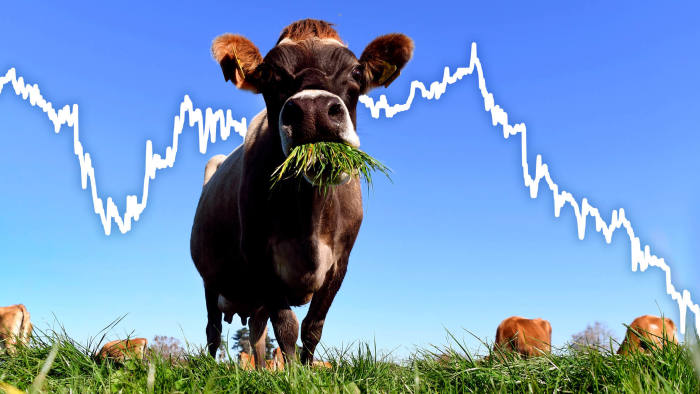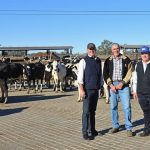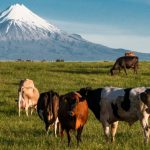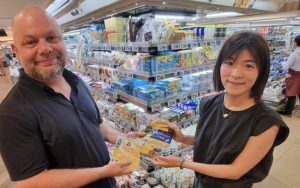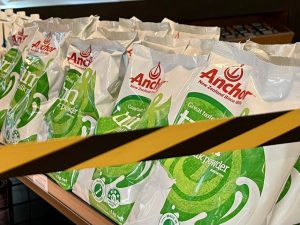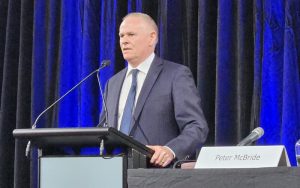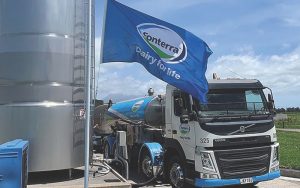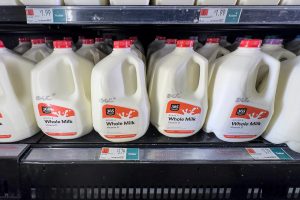
New Zealand’s dairy farmers are known for their conservatism, not their rebelliousness. But some are calling for heads to roll at Fonterra, by far the world’s biggest dairy exporter, as it prepares to report record losses and its latest strategy reset.
“I’ve been a supplier from the beginnings of Fonterra and stuck with them through thick and thin,” said Gavin Faull, who has a 1,200-cow herd in the Taranaki region of the Pacific nation’s North Island. “But I’ve lost millions — every farmer must now be asking, why?”
Founded in 2001 as a “national champion” co-operative to represent the interests of New Zealand’s dairy farmers, Fonterra has grown into a global giant processing milk in New Zealand, Australia, China and Latin America. It supplies almost a third of global milk exports, with China generating about a fifth of the group’s NZ$20.4bn (US$13bn) in revenues in 2018.
The souring of Fonterra’s fortunes — and those of the 10,000 farmer shareholders who own it — marks a dramatic fall from grace that has called the company’s strategy and structure into question.
A fortnight ago it said it would write down the value of troubled businesses in China, Australia, Venezuela, Brazil and New Zealand by about NZ$820m. For the first time in its history it will not pay an annual dividend, as it struggles to honour covenants on a NZ$7.4bn debt mountain.
The mood darkened further a few days later when the company revealed that former chief executive officer Theo Spierings had been paid NZ$4.7m in bonuses and salary when he resigned a year ago after the scale of Fonterra’s troubles became known.

Shane Jones, New Zealand’s minister for regional development, alleged the Netherlands-born Mr Spierings had “destroyed more dairy farming wealth” than the global financial crisis”.
Damien O’Connor, agriculture minister, called on all Fonterra’s managers to take a pay cut.
Mr Faull goes further, saying the company’s directors should resign. “We’ve been hugely loyal,” he said. “But now the dairy farmer feels he’s out of control of his wealth.”
The problems at New Zealand’s biggest company by revenues have shocked farmers, about a third of whom are struggling to repay their own bank debts built up during a decade-long expansion, according to central bank data. It is also a concern for the wider economy, given that Fonterra dairy products, including milk powder and cheese, make up a quarter of New Zealand’s exports.
The writedown extended a losing run for Fonterra shares, which closed at NZ$3.43 on Friday, almost half their value of 18 months ago.

Fonterra’s precipitous fall follows a decade of soaring ambition and ill-fated investments.
Mr Spierings and John Wilson, who resigned as chairman last year because of ill health, attempted to transform Fonterra from a commodity milk processor into a producer of value-added dairy products, brands and food services. The company invested NZ$1bn in a China farm business, NZ$750m in infant formula maker Beingmate and hundreds of millions of dollars in Latin American and Australian dairy businesses, all of which have underperformed and are lossmaking.
“Fonterra began increasingly to see itself as an international dairy powerhouse,” said Keith Woodford, an agri-food systems consultant. “That perspective drove the strategy for more than 10 years but the implementation was woeful.”
Mr Woodford believes the co-operative will have to sell off assets or raise fresh money from its farmer shareholders to reduce its debt. While Fonterra sold its profitable Tip Top ice cream business for NZ$380m in May, he said finding a buyer for its lossmaking businesses would be much harder.
Fonterra said it would unveil its new strategy on September 12 along with its annual results and has flagged a big shake-up, including reforming its capital structure, shedding non-core assets and becoming more transparent. However, it will remain a co-operative.
The multibillion-dollar investment drive to take on global food giants such as Danone and Nestlé was built on shaky foundations, according to the company’s detractors, who point to deficiencies in Fonterra’s capital structure and weak governance.
Under the co-operative structure farmers who supply milk to Fonterra must buy shares in the company. Institutional and retail investors can invest in non-voting shares listed on the New Zealand and Australian stock markets, which in good times should produce a steady stream of dividends.
Critics say this creates a conflict of interest between farmer shareholders, who want Fonterra to pay the highest price possible for their milk, and institutional shareholders, who benefit from profits generated by the co-operative’s value added businesses. The complex structure makes it difficult to raise fresh capital, a factor that has led Fonterra’s reliance on debt to fuel expansion.
“The capital structure places too much risk on farmers,” said Tom Mason, a Fonterra shareholder and chief executive of a dairy business with 3,500 cows. “Fonterra does a good job of collecting and processing New Zealand milk. But it doesn’t have the management skill or capital structure to pursue ambitious investments overseas in consumer businesses.”

It is not the first time Fonterra has been tripped up overseas. In 2005 it bought a 43 per cent stake in Sanlu, a Chinese milk processor, for NZ$250m. Three years later Sanlu was at the centre of a high-profile scandal involving powder tainted with the chemical melamine, which led to the deaths of six babies and the hospitalisation of tens of thousands of others. Sanlu went bankrupt and Fonterra had to write off its investment.
Colin Armer, a farmer shareholder and former director of Fonterra who resigned in 2012, blames poor governance at the co-operative for its difficulties. “We had a loose chief executive officer who was given free rein with a board which did not hold him to account,” he said.
Mr Armer said there was a need for fundamental reform of how the company operates, noting that the current chairman, John Monaghan, was part of the old regime that steered Fonterra into trouble.
Greg Gent, chairman of Dairy Holdings, which has written down the value of its shareholding in Fonterra by NZ$24m over the past two years, said the board was “out of its depth” and the relationship between Fonterra and its auditor PwC “appears too close”.
Two of Fonterra’s directors are former PwC partners and the chairman of Fonterra Shareholder Fund, the unit trust set up to enable retail and institutional investors to buy non-voting shares, is the consultancy’s former chairman John Shewan. PwC has earned more than NZ$90m in audit fees from Fonterra since it was first appointed 2004.
Following criticism at its annual meeting this year, Fonterra recommended replacing PwC with KPMG for the 2020 financial year — a proposal to be voted on by shareholders in November.
PwC did not respond to a request for comment.
Analysts expect the new strategy pursued by the board to focus on Fonterra’s core strength: its milk processing and ingredients business in New Zealand. But the risk is that farmers would switch to a growing number of rivals.
Mr Mason stopped supplying Fonterra with milk in May and others are likely to follow suit. The co-operative’s market share has fallen from 95 per cent in 2001 to about 82 per cent last year. TDB Advisory, a Wellington-based corporate finance adviser, forecasts it will fall to 75 per cent by 2031.
“Fonterra lost sight of what its purpose was and what was important as it tried to do more glamorous things — and as it turned out didn’t do them very well,” said Mr Mason. “And all the other competing companies now have milk flowing into their factories.”
Rival with 230 staff is New Zealand’s most valuable company
Fonterra’s difficulties have proved an opportunity for a2 Milk, a New Zealand rival that last year leapfrogged Fonterra and Auckland International Airport to become the nation’s most valuable listed company.
A2 claims its products, which are free of the A1 beta-casein protein found in most other milks, have greater digestive benefits. Its infant formula is gaining popularity in China, where it has captured 6 per cent of the market.
Analysts say the NZ$11bn company, which has just 230 employees, has succeeded where the 23,000-strong Fonterra has failed: by building a leading international brand. A2 is forecasting 28 per cent earnings growth next year, as it continues to push into the US, China and other Asian markets.
Fonterra owned a 50 per cent share of the original patent for the type of milk produced by a2 but was initially sceptical over the health claims. After hostility between the two groups in their early years, including a high-profile lawsuit, they signed a strategic alliance last year, which includes milk supply, distribution and marketing.
“Well if you can’t beat them join them” said Jayne Hrdlicka, chief executive a2, when asked about the turnround in relations between the companies.
Ms Hrdlicka said she was confident Fonterra’s strategic review will not harm the two companies’ alliance.
